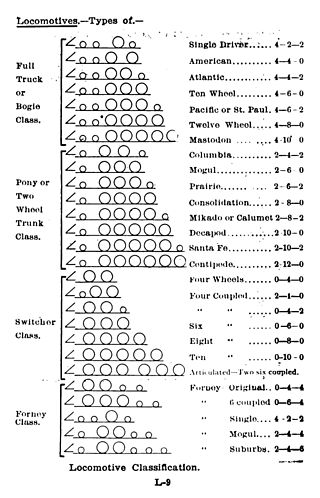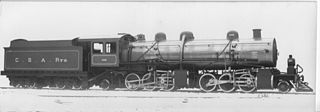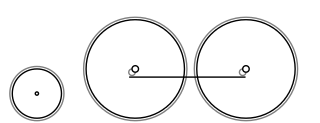
A Mallet locomotive is a type of compound articulated steam locomotive, invented by the Swiss engineer Anatole Mallet (1837–1919).

The Whyte notation is a classification method for steam locomotives, and some internal combustion locomotives and electric locomotives, by wheel arrangement. It was devised by Frederick Methvan Whyte, and came into use in the early twentieth century following a December 1900 editorial in American Engineer and Railroad Journal.
The UIC classification of locomotive axle arrangements, sometimes known as the German classification or German system, describes the wheel arrangement of locomotives, multiple units and trams. It is used in much of the world, notable exceptions being the United Kingdom, which uses a slightly simplified form of UIC, and in North America, where the AAR wheel arrangement system is used to describe diesel and electric locomotives. In North America, the Whyte notation is only used for steam locomotives.
Locomotive classification on the Pennsylvania Railroad took several forms. Early on, steam locomotives were given single-letter classes. As the 26 letters were quickly assigned, that scheme was abandoned for a more complex system. This was used for all of the PRR's steam locomotives, and — with the exception of the final type bought — all electric locomotives also used this scheme.
Under the Whyte notation for the classification of steam locomotive wheel arrangements, a 2-10-10-2 is a locomotive with two leading wheels, two sets of ten driving wheels, and a pair of trailing wheels.

The three L-1 0-8-8-0 Mallet-type steam locomotives of the Erie Railroad, built in July 1907 by ALCO, and numbered 2600, 2601 and 2602 ; were unique in that they were the only articulated camelback locomotives ever built.
A 2-8-8-2, in the Whyte notation for describing steam locomotive wheel arrangements, is an articulated locomotive with a two-wheel leading truck, two sets of eight driving wheels, and a two-wheel trailing truck. The equivalent UIC classification is, refined to Mallet locomotives, (1'D)D1'. These locomotives usually employ the Mallet principles of articulation—with the rear engine rigidly attached to the boiler and the front engine free to rotate—and compounding. The 2-8-8-2 was a design largely limited to American locomotive builders. The last 2-8-8-2 was retired in 1962 from the N&W's roster, two years past the ending of steam though steam was still used on steel mill lines and other railroads until 1983.

In the Whyte notation for the classification of steam locomotives by wheel arrangement, a 2-8-8-0 is a locomotive with a two-wheel leading truck, two sets of eight driving wheels, and no trailing truck.

Under the Whyte notation for the classification of steam locomotives by wheel arrangement, 2-4-4 is a steam locomotive with two unpowered leading wheels followed by four powered driving wheels and four unpowered trailing wheels. This configuration was only used for tank locomotives; no tender locomotives with this wheel arrangement were made.

Under the Whyte notation for the classification of steam locomotives, a 4-8-8-2 is a locomotive with four leading wheels, two sets of eight driving wheels, and a two-wheel trailing truck.

Under the Whyte notation for the classification of steam locomotives by wheel arrangement, a 2-6-6-2 is a locomotive with one pair of unpowered leading wheels, followed by two sets of three pairs of powered driving wheels and one pair of trailing wheels. The wheel arrangement was principally used on Mallet-type articulated locomotives, although some tank locomotive examples were also built. A Garratt locomotive or Golwé locomotive with the same wheel arrangement is designated 2-6-0+0-6-2 since both engine units are pivoting.
In Whyte notation, 2-4-4-2 refers to a railroad steam locomotive that has two leading wheels followed by two sets of four coupled driving wheels and two trailing wheels.

Under the Whyte notation for the classification of steam locomotives, 2-4-0 represents the wheel arrangement of two leading wheels on one axle, four powered and coupled driving wheels on two axles and no trailing wheels. In most of North America it became known as a Porter.
Under the Whyte notation for the classification of steam locomotives, a 2-8-8-8-2 has two leading wheels, three sets of eight driving wheels, and two trailing wheels. Because of its length, such a locomotive must be an articulated locomotive. It is not longer than a normal articulated; the third set of drivers is located under the tender. All of the examples produced were a Triplex of the Mallet type.
Under the Whyte notation for the classification of steam locomotives, a 2-8-8-8-4 has two leading wheels, three sets of eight driving wheels, and four trailing wheels.

A 2-6-8-0 steam locomotive, in the Whyte notation for describing locomotive wheel arrangements, has two leading wheels, a set of six driving wheels, a set of eight driving wheels, and no trailing wheels. These locomotives usually employ the Mallet principle of articulation, with a swinging front engine and a rigidly attached rear engine.

Under the Whyte notation for the classification of steam locomotives, 0-6-0+0-6-0 represents the wheel arrangement of an articulated locomotive with two separate swivelling engine units, each unit with no leading wheels, six powered and coupled driving wheels on three axles and no trailing wheels. The arrangement is effectively two 0-6-0 locomotives operating back-to-back and was used on Garratt, Double Fairlie, Meyer and Kitson-Meyer articulated locomotives. A similar arrangement exists for Mallet steam locomotives on which only the front engine unit swivels, but these are referred to as 0-6-6-0.
A triplex locomotive was a steam locomotive that divided the driving force on its wheels by using three pairs of cylinders to drive three sets of driving wheels. Any such locomotive will inevitably be articulated. All triplex locomotives built were of the Mallet type, but with an extra set of driving wheels under the tender. The concept was extended to locomotives with four, five or six sets of drive wheels. However, these locomotives were never built, except for one quadruplex locomotive in Belgium.
In the Whyte notation for the classification of steam locomotive wheel arrangement, a 2-4-4-0 is a locomotive with two leading wheels, two sets of four driving wheels, and no trailing wheels. Examples of this type were constructed as Mallet locomotives.
Under the Whyte notation for the classification of steam locomotives, a 2-8-8-8-8-2 has two leading wheels, four sets of eight driving wheels, and two trailing wheels. Because of its length, such a locomotive must be an articulated locomotive. It is not longer than a normal articulated; the fourth set of drivers is located under the tender.











